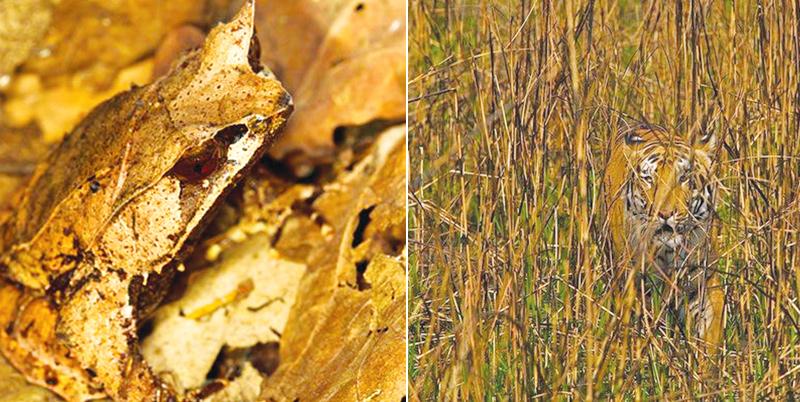

In the struggle for survival that continues in the wild, predators and prey have devised many ways of outwitting one another. It is a biological arms race and at any time either protagonist can be ahead. One successful strategy is to become ‘invisible’ simply by blending in with the background, a method that is practiced by both hunter and hunted. The tiger’s stripes, for instance, look gaudy when seen in a zoo, but in its natural home in an Asian forest the colour of its fur enables it to merge with the leaves, branches and dappled sunlight in the undergrowth. From its hidden position the tiger is able to creep up on or ambush unsuspecting prey. Similarly, a young deer with mottled brown or spotted fur can lie motionless in the vegetation and avoid being spotted by a hungry tiger.

Camouflage is not confined to the higher animals, since ‘cryptic colouring’ of one sort or another is used by all kinds of creatures to gain a meal or to stay off the menu of another creature. The simplest form of camouflage is ‘colour matching’. Many caterpillars are green because they live and feed among green leaves, while creatures such as wolf-spiders, scuttling about on the bare ground, are brown. The shadow on the underside of an animal’s body may give its position away, and so many animals employ ‘countershading’. The body is dark above but paler below and when seen from the side its solid, three-dimensional appearance is transformed, so that it looks like a flat object, difficult to spot initially or locate accurately. Deer and antelope have pale bellies for this reason.
Many fish and sea birds go one better. Seen from below, the silvery underside of a fish becomes invisible against the brightness of the sea’s surface.
Animals
 Viewed from above, the darker colours of the fish’s back merge with the gloom of the ocean’s depths. Similarly, the pale belly plumage of a sea bird blends in with the glare from the sky and the darker plumage on its back merges with the darker colour of the sea or the rocks below. Some animals go to amazing lengths to be inconspicuous; they very precisely imitate inanimate or inedible objects. Frogmouths are nocturnal birds, living in the forests of Australia and South-east Asia that pass the day posing as branches, to the extent that their markings mimic the texture of peeling bark. Looper caterpillars, stick insects and some praying mantises look like twigs, while other mantises, katydids (a kind of tropical grasshopper), bush crickets and leaf insects resemble leaves, they even sport lifelike patterns of veins.
Viewed from above, the darker colours of the fish’s back merge with the gloom of the ocean’s depths. Similarly, the pale belly plumage of a sea bird blends in with the glare from the sky and the darker plumage on its back merges with the darker colour of the sea or the rocks below. Some animals go to amazing lengths to be inconspicuous; they very precisely imitate inanimate or inedible objects. Frogmouths are nocturnal birds, living in the forests of Australia and South-east Asia that pass the day posing as branches, to the extent that their markings mimic the texture of peeling bark. Looper caterpillars, stick insects and some praying mantises look like twigs, while other mantises, katydids (a kind of tropical grasshopper), bush crickets and leaf insects resemble leaves, they even sport lifelike patterns of veins.
When the real leaves have dropped from the tree and come to rest on the forest floor, there are horned frogs and a multitude of ground-dwelling insects that have adopted a mottled brown coloration to merge with the decomposing of leaf litter in which they hide.
On the bottom of the sea, fish play the same cryptic game. For example, the aptly named stone fish, also notable for its venomous spines, looks remarkably like a stone, and the leafy sea dragon, a relative of the sea horse, resembles a piece of floating seaweed. Flatfishes, such as turbot and brill, are able to change the colour of their skin in order to match the colour and texture of the seabed on which they rest. But what if the background colour changes? An Arctic fox, willow grouse or snowshoe hare with pure white fur or feathers would be very conspicuous when the snow melts, so they solve the problem by changing colour, not instantly like the flatfish, but gradually modifying their coat or plumage in order to adapt to the changing seasons.
Spring
In the spring, when the browns and greens of vegetation begin to appear but patches of snow still lie on the ground, these creatures molt most, but not all, of their white fur or feathers.
By early summer, when the snow has disappeared completely, the animals have followed suit and are dressed in brown. When the snows of winter return, they molt their summer coats to revert to pure white once more.
